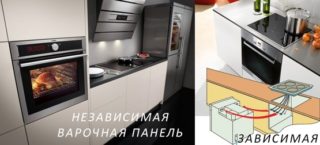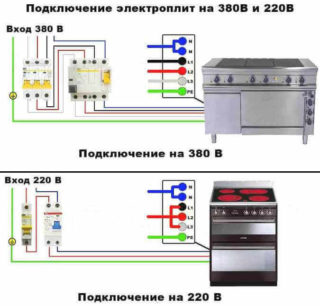In apartment buildings, especially older buildings, there is one electrical cable in the kitchen. It is designed to connect an electric stove. But modern equipment is developing, and a more developed and powerful technique has come to replace the usual stove, which requires a greater load. Dependent and independent ovens and hobs are very popular. In this case, you need to connect the hob and oven to the same outlet. It is necessary to carry out the connection taking into account all the nuances and observing safety measures.
Plate parameters and outlet selection
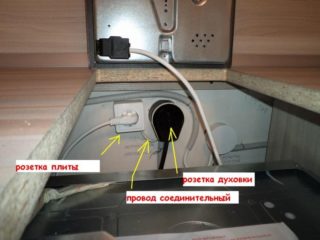
Modern ovens and hobs belong to the category of powerful household appliances. To operate, they require power from up to 10 kW. To connect such equipment, you need to select the correct outlet and cable of the appropriate cross section. Household appliances with a capacity of up to 3.5 kW are equipped with their own 16 A socket and are designed for 220 V.
For the hob, you need to select the entire set for connecting to the mains yourself. Powerful devices with loads from 3.6 kW to 7 kW must be connected via a 32 A power outlet.
Power outlets are overhead and internal. Overhead products are used when laying electrical wiring in an open way. Typically, such models are installed in wooden houses and rooms with a high level of humidity due to their protection from dust and water. Internal sockets are wall mounted and used in panel and brick buildings.
By purpose and design features, sockets are:
- for single-phase 220V networks;
- for three-phase networks 380V;
- having a separate contact for grounding or without it;
- with fixation, push-button or threaded, using a union nut;
- with integrated devices - RCD, trip relay, timer;
- with shutters covering the outlet openings.
The main criteria for choosing outlets for ovens:
- Current strength. You need to know in advance the maximum load from household appliances that will be connected to the power point. Based on this value, an electrical outlet is selected.
- Phase - 220 V or 380 V. In apartments, single-phase networks, in country houses - three-phase.
- The degree of protection against moisture and dust. It is written as IPxx, where the first digit is the level of protection against dust, the second is the protection against moisture. The kitchen is a room with a high level of humidity, for which the minimum indicator is IP24.
The apartment has wiring with its own parameters, made of a certain material. This data will be required for further connection of household appliances.
Houses built before 2001 used aluminum wiring. New homes or buildings that have undergone major overhaul with replacement electrical wiring are equipped with safer and more stable copper wires.
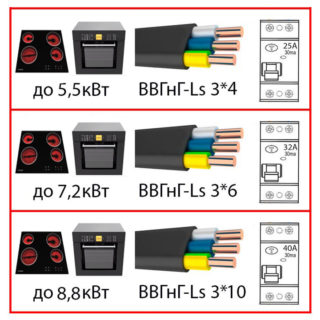
The cable cross-section is selected taking into account the load. You can find it out using special tables, which show the dependence of the wire diameter on the connected load. The calculation is based on PUE 7. For example, for a copper cable with a cross section of 6 sq. mm, the maximum power should not exceed 7.4 kW for hidden wiring and 11 kW for open wiring. For aluminum wire of a similar cross-section, these values will be 5.7 kW for hidden and 8.5 for open wiring.A copper cable with a cross section of 4 sq. Mm can supply a maximum power of up to 5.9 kW with hidden wiring and up to 9 kW with open wiring. A similar aluminum cable withstands 4.6 kW and 7 kW, respectively.
The cable must be double insulated, made of non-combustible and waterproof material. It is recommended to take VVG wires with three or five cores (depending on the number of phases).
Choice of remedies
Protective equipment must be installed on powerful household appliances. These include circuit breakers and RCDs. An oven and hob with a power of up to 5.9 kW requires a 32 A circuit breaker. The machine current is similarly selected from the table, taking into account the total load.
When choosing a machine, you need to take the closest value, which is slightly higher than the calculated current. The values cannot be greatly overestimated. In this case, the risk of skipping the excess load increases, which can lead to equipment failure or fire.
What is the difference between an independent oven and a dependent
Dependent models are installed in niches of specially designed furniture. The oven and hob are stacked on top of each other. They have a single system for connecting to electricity and a common control method. You cannot use them separately from each other. Such devices are widely represented on the home appliance market.
Independent devices are gradually replacing dependent ones. They are distinguished by convenience, ease of installation and use. The oven and hob are not connected to each other, they can be controlled separately. They have no common wires, which makes the connection process easier. The control method for each device can be different - touch, keyboard, remote.
Equipment connection
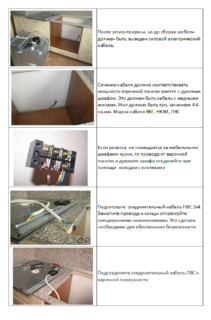
Algorithm for connecting the hob and oven to one outlet:
- Selection of the necessary materials (electrical outlets, cables, professional tools).
- Selection of the optimal connection scheme.
- Installation of a separate circuit breaker for the plate in the switchboard and laying a separate cable from it.
- Installing the socket and connecting the plug with cable.
To install the hob, you will need the following tools:
- drill;
- electric jigsaw;
- knife;
- screwdrivers;
- ruler;
- pencil;
- square;
- cardboard.
Installation is carried out in 3 stages:
- Measurement of the dimensions of the slab. Based on the measured data, you need to create a template on cardboard, which is then transferred to the surface of the cabinet.
- The marked part must be cut out to install the plate. This is done with a jigsaw along the marked contour.
- The final stage is the installation and fastening of the slab. The hob is placed in the hole made. The joints should be sealed with sealant.
According to the current requirements of SNiP, the stove can only be connected through a separate power cable. It is forbidden to install sockets and other points of consumption of electricity on it.
To evenly distribute the load on the network, you can implement a circuit with two phases, zero and ground. When connecting, it is important not to mix up the wires. Alphanumeric marking is made on counters, machines and other devices. The letters 1L, 2L, 3L indicate phases, N - zero. The earth is indicated by the corresponding icon or letters PE. The veins are usually marked with colors. The green-yellow wire always indicates ground (yellow with a green stripe). Zero is marked in light blue or blue. The phase can be painted in any other color.
The panel must be connected to the cable through a dedicated terminal box or a power outlet. The first method is often used by professional electricians.It is reliable, but inconvenient to use. If it is necessary to dismantle the panel, you will have to disconnect the wires in the terminal box, and then reconnect them. Using a plug and socket will simplify the procedure.
The cable can be connected to a plug and socket in several ways. The first way - the core is stripped from the insulating coating by 5 mm and fixed with a screw. The second method is safer and more sustainable. The conductor to be connected is stripped of the protective layer by about 1.5 cm, folded in a ring around the fixing screws and clamped. Safety is achieved by increasing the contact area.
The wire can consist of many thin strands. They are easily destroyed during operation, therefore it is recommended to process them with a soldering iron.
The terminal block or socket must be installed close to the plate. The installation site must be accessible so that the user can reach it if necessary.

